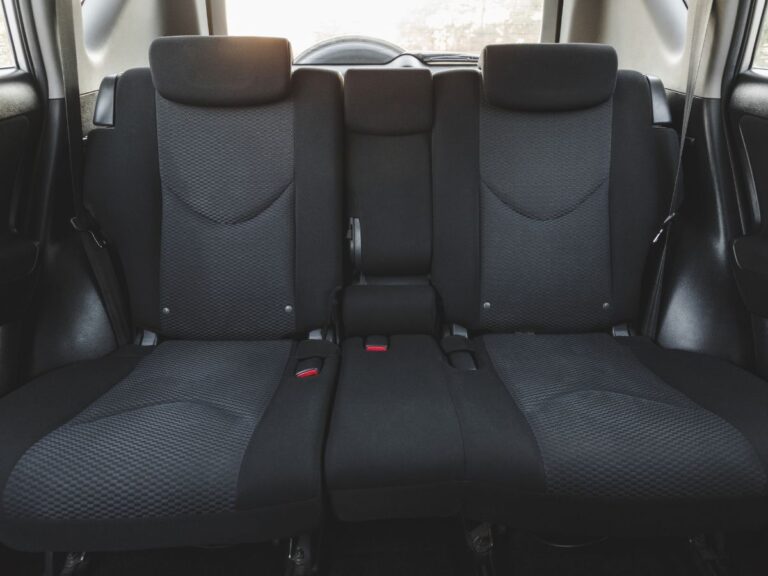Safety Measures for Sleeping in a Car With the AC On: a Comprehensive Guide
Guarantee safety while sleeping in a car with the AC on by prioritizing ventilation, secure parking, and carbon monoxide detection. Regularly maintain the AC system, have an emergency exit plan, and monitor battery usage. Keep fire safety tools nearby and adapt to weather conditions. Remember to dress comfortably, stay hydrated, and be cautious with electrical connections. Prioritize personal safety items and practice fire safety protocols. These measures will help you rest comfortably and securely.
Proper Ventilation
Ensuring adequate airflow inside your car while sleeping with the AC on is essential for maintaining a safe and comfortable environment. Proper ventilation efficiency is vital to prevent the buildup of harmful gases and guarantee fresh air circulation throughout the night. To maximize ventilation, it is recommended to crack open windows slightly on both sides of the vehicle. This strategic window placement allows for cross ventilation, promoting better air circulation and reducing the chances of feeling stuffy or suffocated inside the car.
Safety precautions should be taken when leaving windows open, especially in urban or unfamiliar areas. Be mindful of the surroundings and only leave windows open enough to allow for sufficient airflow while maintaining security. Remember to lock all other doors and windows that are not in use to prevent unauthorized access to the vehicle. By following these guidelines on window placement and air circulation, you can create a well-ventilated sleeping space inside your car, ensuring a restful and safe night’s sleep.
Location Matters
When considering where to park your car for sleeping with the AC on, it’s essential to choose spots that are safe and legal. Ideal locations include designated rest areas, campgrounds, or well-lit parking lots. Ensuring proper ventilation is vital for both comfort and safety during your rest.
Ideal Parking Spots
To maximize safety and comfort while sleeping in a car with the AC on, selecting ideal parking spots with proper considerations is essential. When choosing a parking spot for overnight stays, adhere to parking etiquette by selecting designated parking areas such as rest stops, campgrounds, or well-lit parking lots. These locations offer increased security and reduced noise levels compared to secluded or dimly lit areas. Security concerns are paramount; opt for spots with surveillance cameras or security patrols to deter potential threats. Adequate lighting is vital for visibility and safety. Look for spots with sufficient lighting options to make sure you can easily monitor your surroundings. Avoid parking in areas with limited visibility or high crime rates. By prioritizing security, adhering to parking etiquette, and considering noise levels and lighting options, you can greatly enhance your safety and comfort while sleeping in a car with the AC running.
Ventilation and Safety
Selecting an appropriate location for ventilation and safety when sleeping in a car with the AC on is important for guaranteeing a comfortable and secure rest. Proper air circulation is vital to prevent stuffiness and ensure a fresh supply of oxygen throughout the night. When choosing a spot, consider areas with minimal obstructions to allow for the free flow of air. Parking under a shaded area can help with heat management, as direct sunlight can cause the car’s interior to heat up quickly, leading to discomfort and potential health risks. Additionally, avoid parking near sources of pollutants or exhaust fumes to maintain good indoor air quality.
To enhance ventilation and safety, crack open the windows slightly to allow for cross ventilation, promoting airflow within the vehicle. This simple step can help regulate the temperature inside the car and reduce the buildup of humidity. Remember to prioritize your safety by ensuring the windows are only partially open to maintain security while still allowing for adequate airflow. By carefully selecting a well-ventilated and safe location for sleeping in your car with the AC on, you can create a conducive environment for a restful night’s sleep.
Carbon Monoxide Detector
You must guarantee proper placement of your carbon monoxide detector in the car to effectively monitor levels of the gas. If the alarm sounds, immediately open the windows and doors to ventilate the area and exit the vehicle to a safe location. Taking swift action upon hearing the alarm is vital in preventing carbon monoxide poisoning while sleeping in a car with the AC on.
Detector Placement
Proper placement of a carbon monoxide detector in your car is essential for effective monitoring during sleep. To guarantee accurate readings, place the detector at breathing level, ideally within 5 feet of where you sleep. This location allows for quick detection of any harmful gases, such as carbon monoxide, that may accumulate inside the vehicle. Regular detector maintenance, including checking the batteries and testing its functionality, is vital to ensure it operates at its best. Following safety protocols ensures that your detector is dependable in case of an emergency.
Consider the detector’s sensitivity to avoid false alarms. Avoid placing it directly near air vents, heaters, or windows where external fumes may interfere with its readings. Additionally, refrain from placing the detector in areas prone to extreme temperature changes, as this can impact its accuracy. By implementing these placement guidelines and adhering to maintenance practices, you can enhance the effectiveness of your carbon monoxide detector and prioritize your safety while sleeping in a car with the AC on.
Alarm Response
For the best safety when sleeping in a car with the AC on, ensuring a prompt and reliable response from your carbon monoxide detector in the event of elevated gas levels is vital. Emergency response and safety protocols are essential components in safeguarding against carbon monoxide poisoning. Your carbon monoxide detector should be equipped with alarm systems that can immediately notify you of any dangerous gas levels. It is essential to test your detector regularly to make sure it is functioning correctly and to replace the batteries as needed.
In the event of an alarm sounding, it is important to have a clear plan of action. React promptly by opening windows, turning off the car engine, and exiting the vehicle to get fresh air. If you suspect carbon monoxide exposure, seek medical attention immediately. Familiarize yourself with the alarm sounds and notification methods of your carbon monoxide detector to respond effectively in case of an emergency. By following these safety measures and being proactive in your alarm response, you can greatly reduce the risks associated with sleeping in a car with the AC on.
Regular AC Maintenance
Regular maintenance of the car’s air conditioning system is essential to guarantee peak performance and longevity. Make sure to regularly check and replace the AC filter to prevent dust and debris from clogging the system, which can hinder airflow and reduce efficiency. Additionally, monitoring refrigerant levels is vital to ensure that your AC is cooling properly; low refrigerant levels can lead to decreased cooling capacity.
Schedule regular tune-ups and professional checks to keep your AC system running smoothly. A professional can inspect for any leaks, check the compressor, and assess overall system performance. This proactive approach can help identify and address any potential issues before they escalate, ensuring that your AC functions efficiently when needed.
Emergency Exit Plan
Identify potential exit routes within your vehicle, ensuring easy access in case of emergencies. Practice opening windows swiftly to familiarize yourself with the process in high-stress situations. Keep emergency tools like a seatbelt cutter and window breaker within reach for quick and efficient use when needed.
Exit Routes Identified
In case of an emergency, make sure that there are clear and accessible exit routes identified from your vehicle when sleeping with the AC on. Knowing how to swiftly exit your car in urgent situations is important for your safety. As part of your emergency procedures, it is advisable to conduct safety drills to familiarize yourself with the quickest and safest ways to leave your vehicle.
To begin, confirm that all doors can be easily opened from the inside and that windows can be opened without difficulty. Familiarize yourself with the location of door handles and window controls, especially in the dark or if visibility is poor. Additionally, keep pathways clear within the car to prevent any obstructions that could impede your exit.
Remember that during emergencies, time is of the essence. Thus, by proactively identifying and practicing your exit routes, you can enhance your preparedness and potentially prevent accidents or injuries. Your safety is paramount, and being well-prepared can make a significant difference in critical situations.
Practice Opening Windows
Make sure that you can swiftly and confidently open the windows of your car as part of your emergency exit plan. In addition to providing ventilation, being able to open the windows efficiently is vital for safety in case of an emergency. Practicing how to open your car windows quickly can make a significant difference when every second counts.
Window fogging can be a common issue when sleeping in a car with the AC on. By having the windows cracked open slightly, you can help regulate the temperature inside the vehicle and prevent condensation buildup. This simple step can also improve air circulation, creating a more comfortable sleeping environment.
When practicing opening your windows, take note of any safety precautions specific to your vehicle. Make sure that the windows are functioning correctly and that there are no obstructions preventing them from opening smoothly. By familiarizing yourself with the process, you can react promptly in case of an emergency and safeguard your well-being.
Emergency Tools Accessible
Make sure that emergency tools are easily accessible in your car as part of your readiness for potential exit scenarios. In case of an emergency while sleeping in your car with the AC on, having quick access to essential items can make a critical difference. To start with, make sure you have an emergency communication device like a fully charged cell phone or a portable charger. Additionally, a safety kit containing items such as a flashlight, first aid supplies, and a multi-tool can prove invaluable during unforeseen situations. Place these items within reach, preferably in the front seat or a designated compartment that is easily accessible from the driver’s seat.
Furthermore, consider displaying warning signs on your car windows indicating that someone is inside and may need assistance in case of an emergency. It is also advisable to have an emergency contact saved in your phone and memorized, enabling swift communication in urgent scenarios. By being prepared with accessible emergency tools and communication resources, you can enhance your safety while sleeping in your car.
Window Crack for Fresh Air
To guarantee proper ventilation while sleeping in a car with the AC on, consider cracking the window slightly for fresh air intake. Fresh air circulation is vital for your safety and well-being when resting in a vehicle. By allowing a small opening in the window, you can maintain a continuous flow of fresh air, preventing the interior from becoming stuffy or lacking oxygen.
When deciding on the window crack size, it’s important to find a balance between ventilation and security. A small opening of about one to two inches is generally sufficient to promote air circulation while minimizing the risk of unwanted intrusions. This size provides benefits such as maintaining a comfortable temperature inside the car, reducing condensation buildup, and preventing the air from feeling stale.
Remember to crack a window on the opposite side of where you are sleeping to encourage cross-ventilation and improve air quality. By following these window crack tips, you can create a safer and more comfortable environment for sleeping in your car with the AC running.
Avoiding Overheating
For ideal comfort and safety when sleeping in a car with the AC on, it is essential to implement strategies that prevent overheating. To avoid overheating, it is important to stay well-hydrated. Make sure to have a sufficient amount of water within reach to prevent dehydration, especially in warmer climates. Additionally, choose your clothing wisely. Opt for lightweight, breathable fabrics that allow for better air circulation and moisture-wicking properties. Loose-fitting clothing can also help in keeping your body cool during sleep.
Hydration tips are essential as they help regulate body temperature and prevent heat-related illnesses. Clothing choices play a significant role in maintaining a comfortable body temperature while sleeping in your car. By selecting appropriate attire, you can avoid overheating and ensure a more restful sleep. Remember, preventing overheating is critical for your safety and well-being when sleeping in a car with the AC on.
Safe Electrical Connections
Maintaining proper insulation and secure connections is vital for keeping safe electrical systems in your car while utilizing the AC for sleep. When setting up electrical wiring for your car’s AC system, it is important to follow safety precautions to prevent any risks of short circuits or electrical fires. Start by inspecting the power source compatibility with your car’s electrical system. Confirm that the power source can handle the electrical load required for running the AC unit overnight without overheating or causing damage.
Next, check the electrical wiring for any signs of wear, fraying, or damage. Make sure all connections are secure and free of corrosion, as loose connections can lead to overheating and potentially dangerous situations. Use proper insulation materials for any exposed wires to prevent accidental contact and reduce the risk of electrical hazards. Additionally, consider using surge protectors or voltage regulators to protect your car’s electrical system from power surges or fluctuations that could damage the AC unit or other components. By following these safety measures and conducting regular checks, you can ensure a safe and comfortable sleeping environment in your car while running the AC.
Monitoring Battery Usage
Monitor your car’s battery usage closely when running the AC overnight to guarantee peak performance and avoid potential issues. Keeping an eye on your battery life is important for a safe and comfortable night’s rest in your vehicle. Here are some essential tips to help you manage your battery effectively:
- Check Battery Health Regularly: Make sure your car battery is in good condition before relying on it to power the AC overnight. A weak battery may struggle to maintain power throughout the night, leading to potential disruptions.
- Limit AC Usage: To prevent excessive strain on the battery and minimize the environmental impact, consider using the AC intermittently rather than running it continuously. This practice can help conserve energy and extend battery life.
- Use Energy-Efficient Settings: Opt for lower AC settings or set a timer to regulate the cooling process efficiently. By reducing power consumption, you can prolong your battery’s life span and reduce unnecessary energy usage.
- Have a Backup Plan: In case of unexpected battery issues, always have a backup power source or a plan B for staying cool during the night. This precaution can ensure your safety and comfort in challenging situations.
Fire Safety Precautions
To maintain a safe environment while sleeping in a car with the AC on, it is essential to implement fire safety precautions. Firstly, make sure that your car is equipped with a fire extinguisher suitable for automotive use. Place the fire extinguisher in a readily accessible location within the car, preferably near the driver’s seat for quick access in case of emergency. Additionally, installing a smoke detector in your car can provide an early warning in the event of a fire, allowing you to react promptly.
Developing an emergency plan is vital. Familiarize yourself with the quickest exit routes from the car and have a designated meeting point in case of evacuation. Practice this plan regularly to ensure everyone knows what to do in case of a fire. Moreover, avoid storing flammable materials in the car and never leave candles or any open flames unattended. By following these safety precautions and being prepared with the necessary equipment and plans, you can reduce the risk of fire hazards while sleeping in a car with the AC on.
Weather Considerations
Consider the ambient temperature and humidity levels outside when deciding to sleep in a car with the AC on for best comfort and safety. Proper weather considerations are essential for guaranteeing a restful and safe sleeping environment inside your vehicle. Here are some key factors to keep in mind:
- Temperature Regulation: Adjust the air conditioning settings based on the external temperature to maintain a comfortable sleeping environment. Extreme temperatures can impact the efficiency of the AC system and affect your comfort levels.
- Seasonal Adjustments: Be mindful of seasonal changes and how they may influence the temperature inside your car. During hot summer nights, you may need to lower the AC temperature, while in colder winter months, a higher setting might be more suitable.
- Humidity Levels: Monitor humidity levels as high humidity can lead to discomfort and impact your quality of sleep. The AC can help regulate humidity levels inside the car for a more pleasant sleeping experience.
- Ventilation: Ensure proper airflow inside the vehicle by cracking windows slightly to prevent stuffiness and maintain fresh air circulation. Balancing AC usage with ventilation can help create an ideal sleeping environment.
Personal Safety Items
When sleeping in a car with the AC on, make sure you have personal safety items readily available to address any unforeseen emergencies. A well-equipped emergency kit is vital for your safety. Include items like a first aid kit stocked with bandages, antiseptic wipes, pain relievers, and any personal medications you may need. In case of minor injuries or medical issues, having these supplies within reach can make a significant difference.
Additionally, consider adding emergency tools such as a flashlight with extra batteries, a multi-tool, and a reflective vest to enhance your visibility in case you need to exit the vehicle in low light conditions. These items can prove invaluable during emergencies or when assistance is required.
Remember to periodically check and restock your emergency kit to make certain that all items are in good condition and up-to-date. By being prepared with essential personal safety items, you can sleep more soundly knowing you are ready to handle unexpected situations while sleeping in your car with the AC on.
Ensuring Safety While Sleeping in a Car with the AC On
To sum up, ensuring safety while sleeping in a car with the AC on requires attention to detail and proper preparation. By following the outlined safety measures, such as maintaining ventilation, installing a carbon monoxide detector, and having an emergency exit plan, you can minimize risks and enjoy a comfortable and safe rest. Remember to regularly check your AC system and be prepared for any potential emergencies. Stay safe and sleep soundly in your car.







